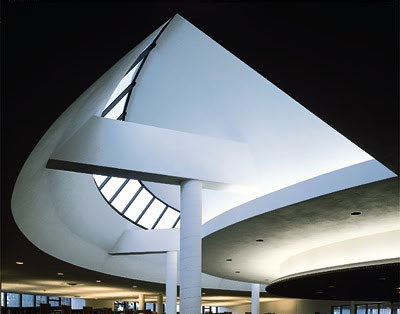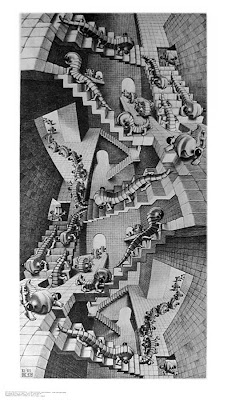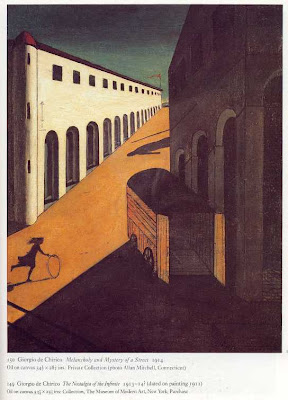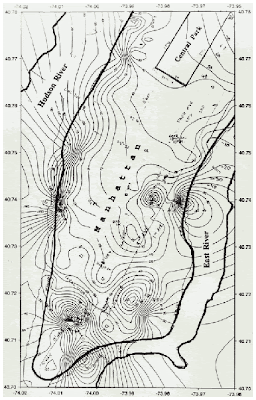“A Work of Art...
is not a living thing ...
that walks or runs.
But the making of a life.
That which gives you a reaction.
To some it is the wonder of Man's Fingers.
To some it is the wonder of the Mind.
To some it is the wonder of Technique.
And to some it is how Real it is.
To some, how Transcendent it is.
Like the 5th Symphony
it presents itself with a feeling that you know it,
if you have heard it once.
And you look for it,
and though you know it you must hear it again.
Though you know it you must see it again.
Truly a work of Art is one that tells us,
that Nature cannot make what man can make.”
Louis Kahn
“To express is to drive.
And when you want to give something presence,
you have to consult nature.
And there is where Design comes in.
And if you think of Brick,
for instance,and you say to Brick,
"What do you want Brick?"
And Brick says to you
"I like an Arch."
And if you say to Brick"
Look, arches are expensive,
and I can use a concrete lentil over you.
What do you think of that?"
"Brick?"
Brick says:"... I like an Arch"”
Louis Kahn
And when you want to give something presence,
you have to consult nature.
And there is where Design comes in.
And if you think of Brick,
for instance,and you say to Brick,
"What do you want Brick?"
And Brick says to you
"I like an Arch."
And if you say to Brick"
Look, arches are expensive,
and I can use a concrete lentil over you.
What do you think of that?"
"Brick?"
Brick says:"... I like an Arch"”
Louis Kahn
“I don't want to be interesting. I want to be good.”
“It is better to be good than to be original.”
“This is no less true of steel and concrete [than of wood, brick and stone]. We must remember that everything depends on how we use a material, not on the material itself....New materials are not necessarily superior. Each material is only what we make it.”
“The long path from material through function to creative work has only one goal: to create order out of the desperate confusion of our time. We must have order, allocating to each thing it's proper place and giving to each thing is due according to it's nature.”
“We must be as familiar with the functions of our building as with our materials. We must learn what a building can be, what it should be, and also what it must not be...”
“If teaching has any purpose, it is to implant true insight and responsibility. Education must lead us from irresponsible opinion to true responsible judgment. It must lead us from chance and arbitrariness to rational clarity and intellectual order.”
Mies van der Rohe
“It is better to be good than to be original.”
“This is no less true of steel and concrete [than of wood, brick and stone]. We must remember that everything depends on how we use a material, not on the material itself....New materials are not necessarily superior. Each material is only what we make it.”
“The long path from material through function to creative work has only one goal: to create order out of the desperate confusion of our time. We must have order, allocating to each thing it's proper place and giving to each thing is due according to it's nature.”
“We must be as familiar with the functions of our building as with our materials. We must learn what a building can be, what it should be, and also what it must not be...”
“If teaching has any purpose, it is to implant true insight and responsibility. Education must lead us from irresponsible opinion to true responsible judgment. It must lead us from chance and arbitrariness to rational clarity and intellectual order.”
Mies van der Rohe
“Form follows function - that has been misunderstood. Form and function should be one, joined in a spiritual union.”
“"Think simple" as my old master used to say - meaning reduce the whole of its parts into the simplest terms, getting back to first principles.”
“Get the habit of analysis- analysis will in time enable synthesis to become your habit of mind.”
“Simplicity and repose are the qualities that measure the true value of any work of art.”
“Study nature, love nature, stay close to nature. It will never fail you.”
“Freedom is from within.”
Frank Lloyd Wright
“"Think simple" as my old master used to say - meaning reduce the whole of its parts into the simplest terms, getting back to first principles.”
“Get the habit of analysis- analysis will in time enable synthesis to become your habit of mind.”
“Simplicity and repose are the qualities that measure the true value of any work of art.”
“Study nature, love nature, stay close to nature. It will never fail you.”
“Freedom is from within.”
Frank Lloyd Wright
Take a look at the drawings of Zaha Hadid - Center for Contemporary Art. Simple easy to read yet complex enough to show intentions.
http://picasaweb.google.com/amoiacody/ZahaHadidCenterForContemporaryArt/photo#s5192100976664107362
http://picasaweb.google.com/amoiacody/ZahaHadidCenterForContemporaryArt/photo#s5192100976664107362
Leicester Engineering Building

"With the engineering building for Leicester University we had to build a new institution of a scientific/educational type. The tower at the front contains the fixed non-expanding accommodation and is intended to be a grouping of identifiable volumes of accommodation, i.e. vertical shafts which are for lifts and staircases, wedge-shaped volumes which are lecture theaters, etc. The back of the building is considered as a shed, within which there can be continuous re-equipping and adjustment of spaces. The total building should read as a conjunction of fixed specific activities and of a variable changing situation, ... "
J. Stirling "Anti-structure", a slide talk by J. Stirling at Bologna University
FINAL PRESENTATION
Let’s think of the final presentation the same way you think about portfolio (this way you don’t need to do it twice!). All sheets are to be consistent in size and composed. Start your layouts now so that we can review as part of the completion and editing process. Knowing what to draw (where to cut plans and sections) is as just important as how much to draw (more detail(s) or more diagrams)
Remember the CONCEPT! These projects are in no way “Buildings”. Architecture is a concept event – ideas must be present for the artistry to show itself. Without this artistry – no architecture – just building (and to use Yiyun’s term “boring”)!
Don’t think of a stair as a “stair”, but a connecting device - a controller of movement.
Don’t think of a facade as a “facade”, but a modulator of light and shadow - a controller of threshold both for movement and light.
Don’t think of a structure as a “structure”, but a conceptual presence that holds form and space - a controller of weight and air – a developer of shape.
Don’t think of a program as a “program”, but as an organizer of sizes in space – a regulator of scale and measure – the organs of a body.
A Producer develops a film by gathering a team – it’s a construction process. Now ask yourself what would that film be without its Director? That creative artist that shapes sequence and sets creative process. Be the Director of your work, not the Producers! Set the scene for your actors – for your forms in space!
If you are serious, creating architecture is difficult yet simple, frustrating yet rewarding, equally conceptual and pragmatic. No “right and wrong” exists in Architecture. No one form is grater than the other. The only real difference between “building” and “architecture” is that the former is just a set of plans, a construction process; the latter is developed to control events that move the sprit, a creative process. It is artful and intentional. The quote by Le Corbusier says it all:
You employ stone, wood and concrete, and with these materials you build houses and palaces; that is construction. Ingenuity is at work. But suddenly you touch my heart, you do me good. I am happy and I say: ‘This is beautiful.’ That is architecture. Art enters in.
Remember the CONCEPT! These projects are in no way “Buildings”. Architecture is a concept event – ideas must be present for the artistry to show itself. Without this artistry – no architecture – just building (and to use Yiyun’s term “boring”)!
Don’t think of a stair as a “stair”, but a connecting device - a controller of movement.
Don’t think of a facade as a “facade”, but a modulator of light and shadow - a controller of threshold both for movement and light.
Don’t think of a structure as a “structure”, but a conceptual presence that holds form and space - a controller of weight and air – a developer of shape.
Don’t think of a program as a “program”, but as an organizer of sizes in space – a regulator of scale and measure – the organs of a body.
A Producer develops a film by gathering a team – it’s a construction process. Now ask yourself what would that film be without its Director? That creative artist that shapes sequence and sets creative process. Be the Director of your work, not the Producers! Set the scene for your actors – for your forms in space!
If you are serious, creating architecture is difficult yet simple, frustrating yet rewarding, equally conceptual and pragmatic. No “right and wrong” exists in Architecture. No one form is grater than the other. The only real difference between “building” and “architecture” is that the former is just a set of plans, a construction process; the latter is developed to control events that move the sprit, a creative process. It is artful and intentional. The quote by Le Corbusier says it all:
You employ stone, wood and concrete, and with these materials you build houses and palaces; that is construction. Ingenuity is at work. But suddenly you touch my heart, you do me good. I am happy and I say: ‘This is beautiful.’ That is architecture. Art enters in.
You employ stone, wood and concrete, and with these materials you build
houses and palaces; that is construction. Ingenuity is at work. But suddenly
you touch my heart, you do me good. I am happy and I say: ‘This is
beautiful.’ That is architecture. Art enters in.
Le Corbusier: Vers une architecture, 1923
houses and palaces; that is construction. Ingenuity is at work. But suddenly
you touch my heart, you do me good. I am happy and I say: ‘This is
beautiful.’ That is architecture. Art enters in.
Le Corbusier: Vers une architecture, 1923
How Epidemics Helped Shape the Modern Metropolis
Cholera Epidemic of 1832
http://www.nytimes.com/2008/04/15/science/15chol.html?ref=science
http://www.nytimes.com/2008/04/15/science/15chol.html?ref=science
Mid-Term Review – Monday April 14, 2008
Mid-Term Review – Monday April 14, 2008 - 6pm sharp (pinned up and ready to go)
Drawings All drawings to be ink on mylar or CAD color plots.
All sheets to be 24”x36” or as required to fit axons and diagrams. All showing thicknesses of material both new and existing.
Plans (4 minimum) Show sidewalk and context.
One at each level
Sections (3 minimum) Show existing building in section (the existing floors and walls).
2 Transverse
1 Longitudinal
Elevations
One of Existing elevation
One of New components only
One of Elevation Complete (new and existing) with min. 3 line weights.
Axonometric
One complete (remove the side party walls, but front elevation must remain part of drawing)
One of program areas only – in color
One of structure only
Exploded axon showing the component parts (existing façade, program, circulation and structure
Diagrams
All diagrams at Half-Size and in color.
One axonometric sequence diagram to show flow of spaces, set of outline plans that shows space and structure, and one set of outline plans that show primary programming structure.
Models
Competed study model with all program, circulation and structure
Create the existing building container for your model so your model can be exposed and so that the neighboring buildings can fit together properly. Use different materials as appropriate or use those outlined below.
Bring you other study models
Photographs
Final Study model complete
Previous study models.
Thesis
Edited thesis board
Notes on the Final Model. All projects will use the SAME materials as follows:
Existing White Museum Board for all existing materials
New Concrete Grey painted basswood
Wood Stained basswood or other wood
Metal Unpainted basswood (include new windows)
Masonry Crème color museum board
Glass Three types:
Clear, Translucent and Opaque Plexiglas
Canvas or Mesh use black fiberglass window screen
Interior walls should use the same materials as above or use strategically painted wood.
Drawings All drawings to be ink on mylar or CAD color plots.
All sheets to be 24”x36” or as required to fit axons and diagrams. All showing thicknesses of material both new and existing.
Plans (4 minimum) Show sidewalk and context.
One at each level
Sections (3 minimum) Show existing building in section (the existing floors and walls).
2 Transverse
1 Longitudinal
Elevations
One of Existing elevation
One of New components only
One of Elevation Complete (new and existing) with min. 3 line weights.
Axonometric
One complete (remove the side party walls, but front elevation must remain part of drawing)
One of program areas only – in color
One of structure only
Exploded axon showing the component parts (existing façade, program, circulation and structure
Diagrams
All diagrams at Half-Size and in color.
One axonometric sequence diagram to show flow of spaces, set of outline plans that shows space and structure, and one set of outline plans that show primary programming structure.
Models
Competed study model with all program, circulation and structure
Create the existing building container for your model so your model can be exposed and so that the neighboring buildings can fit together properly. Use different materials as appropriate or use those outlined below.
Bring you other study models
Photographs
Final Study model complete
Previous study models.
Thesis
Edited thesis board
Notes on the Final Model. All projects will use the SAME materials as follows:
Existing White Museum Board for all existing materials
New Concrete Grey painted basswood
Wood Stained basswood or other wood
Metal Unpainted basswood (include new windows)
Masonry Crème color museum board
Glass Three types:
Clear, Translucent and Opaque Plexiglas
Canvas or Mesh use black fiberglass window screen
Interior walls should use the same materials as above or use strategically painted wood.
Subscribe to:
Comments (Atom)


































